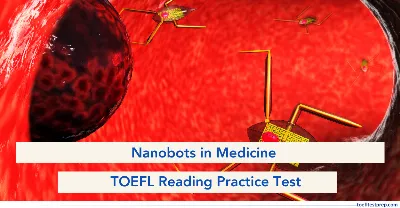Nanobots in Medicine - TOEFL iBT® Reading Practice Test

"Improve your TOEFL Reading skills with passages on 'Nanobots in Medicine,' highlighting their groundbreaking contributions to healthcare."
Key Highlights
Nanobots, microscopic robots designed to operate at the cellular level, are revolutionising modern medicine. From targeted drug delivery to precise diagnostics, these tiny innovations are transforming how diseases are treated and prevented.
By practising TOEFL Reading passages on 'Nanobots in Medicine,' you’ll develop a deeper understanding of complex scientific concepts and improve your ability to extract essential information, a critical skill for test success.
Reading Instructions:
- You have 15 minutes to read the following passage and answer all 9 questions related to it.
- Most questions are worth 1 point, but the last question is worth more. The directions indicate how many points you will receive for that specific question.
- The specific section/paragraphs have been provided again with the question for ease of understanding and quick solution.
- Some questions include a word or phrase that is highlighted in the question as well as in the paragraph for quick reference.
Nanobots in Medicine
The rise of tiny tech has marked an interesting new phase in medicine, especially with the development of nanobotstiny robots designed to carry out particular jobs at the cellular or molecular level. These nanobots, usually measuring between 1 and 100 nanometers, have the possibility to change many medical uses, including targeted drug delivery, diagnostics, and less invasive surgeries. Working at such a small scale allows for incredible accuracy in targeting diseases, reducing side effects, and improving treatment effectiveness. As research moves forward, it seems more and more likely that nanobots will be integrated into clinical practice, offering solutions to significant challenges in todays healthcare, like drug resistance and the need for personalized medicine.
One of the most exciting uses of nanobots is in targeted drug delivery. Traditional ways of giving medication often expose the whole body to the drug, which can cause unwanted side effects and reduce how effective the treatment is. In contrast, nanobots can be carefully designed to deliver drugs directly to sick cells, like cancer cells, maximizing the treatments impact while minimizing harm to healthy cells. For example, a study in the journal *Nature Nanotechnology* showed that nanobots could be programmed to respond to specific signals in the body, releasing their drug only when they reach a target cell. This level of precision not only improves treatment results but also lowers the overall dosage needed, which is
especially helpful in chemotherapy, where high doses can lead to serious side effects.
Also, nanobots can act as effective biosensors, playing a key role in spotting diseases early. These tiny devices can monitor biological markers in real-time, giving important information about a patients health. For instance, researchers have created nanobots that can detect specific proteins or nucleic acids linked to diseases like cancer or infections. Once these markers are found, the nanobots can send this information to healthcare providers, enabling quick action. This ability for early diagnosis is especially important, as it can lead to better outcomes and more effective treatment strategies, ultimately saving lives. The possibility for nanobots to identify diseases at their earliest stages could greatly change preventive medicine.
Even with the interesting possibility of nanobots, there are still several challenges to overcome before they can be widely used in clinics. One major issue is body compatibility; the human immune system might see nanobots as foreign objects and quickly remove them from the bloodstream. Researchers are looking into ways to design nanobots that can avoid detection by the immune system, such as coating them with materials that are friendly to the body or making them mimic natural biological processes. Additionally, the long-term effects of using nanobots in the body are still largely unknown, so thorough research is needed to ensure they are safe and effective. Rules will also need to adapt to address the unique challenges posed by tiny tech in medicine, as current rules may not fully cover the complexities of these advanced devices.
Another important consideration is the moral issues of using nanobots in healthcare. The ability to manipulate biological systems at such a basic level raises questions about consent, privacy, and the potential for misuse. For example, the power to modify or enhance human abilities through tiny tech could lead to ethical dilemmas regarding fairness and access to these advanced medical treatments. Moreover, the possibility of using nanobots for watching or military purposes adds another layer of complexity to the discussion about their development. So, its crucial for everyone involved scientists, ethicists, and policymakersto engage in ongoing conversations to create rules that ensure the responsible use of nanobots in medicine, protecting against potential abuses.
In conclusion, while using nanobots in medicine offers many chances to improve healthcare, it also brings several challenges that need to be addressed. The possibility for targeted drug delivery, early disease detection, and innovative treatment strategies highlights the changing effect of tiny tech on medicine. However, issues related to body compatibility, moral concerns, and regulatory frameworks must be handled carefully to ensure that the benefits of nanobots are realized without compromising patient safety or societal values. As research continues, the future of nanobots in medicine remains an exciting field, full of opportunities for exploration and innovation, with the promise of greatly improving patient care and treatment results. Questions still exist about the long- term effects of their use, suggesting that further investigation is essential to fully understand their impact on modern medicine.
Directions: Once you have read the passage, answer the following questions.
Paragraph 1
The rise of tiny tech has marked an interesting new phase in medicine, especially with the development of nanobotstiny robots designed to carry out particular jobs at the cellular or molecular level. These nanobots, usually measuring between 1 and 100 nanometers, have the possibility to change many medical uses, including targeted drug delivery, diagnostics, and less invasive surgeries. Working at such a small scale allows for incredible accuracy in targeting diseases, reducing side effects, and improving treatment effectiveness. As research moves forward, it seems more and more likely that nanobots will be integrated into clinical practice, offering solutions to significant challenges in todays healthcare, like drug resistance and the need for personalised medicine.
Factual Information Question
- According to paragraph 1, what are some potential medical uses of nanobots?
- Targeted drug delivery
- Traditional surgery
- General health monitoring
- Emergency response
Negative Factual Information Question
- In paragraph 1, each of the following is mentioned as a benefit of nanobots EXCEPT:
- Improved treatment effectiveness
- Reduced side effects
- Increased drug resistance
- Enhanced accuracy in targeting diseases
Paragraph 2
One of the most exciting uses of nanobots is in targeted drug delivery. Traditional ways of giving medication often expose the whole body to the drug, which can cause unwanted side effects and reduce how effective the treatment is. In contrast, nanobots can be carefully designed to deliver drugs directly to sick cells, like cancer cells, maximising the treatment's impact while minimising harm to healthy cells. For example, a study in the journal *Nature Nanotechnology* showed that nanobots could be programmed to respond to specific signals in the body, releasing their drug only when they reach a target cell. This level of precision not only improves treatment results but also lowers the overall dosage needed, which is especially helpful in chemotherapy, where high doses can lead to serious side effects.
- What can be inferred about the role of nanobots in chemotherapy from paragraph 2?
- They eliminate the need for chemotherapy altogether.
- They can help reduce the dosage required for effective treatment.
- They are less effective than traditional chemotherapy methods.
- They are only useful for treating cancer cells.
Rhetorical Purpose Question
- Why does the author mention the study in the journal *Nature Nanotechnology* in
paragraph 2?- To illustrate the potential of nanobots in drug delivery
- To highlight the limitations of traditional drug delivery methods
- To provide evidence of the dangers of using nanobots
- To discuss the history of drug delivery systems
Paragraph 3
Also, nanobots can act as effective biosensors, playing a key role in spotting diseases early. These tiny devices can monitor biological markers in real-time, giving important information about a patients health. For instance, researchers have created nanobots that can detect specific proteins or nucleic acids linked to diseases like cancer or infections. Once these markers are found, the nanobots can send this information to healthcare providers, enabling quick action. This ability for early diagnosis is especially important, as it can lead to better outcomes and more effective treatment strategies, ultimately saving lives. The possibility for nanobots to identify diseases at their earliest stages could greatly change preventive medicine.
Vocabulary Question
- The word biosensors in paragraph 3 is closest in meaning to:
- Devices that enhance physical abilities
- Instruments that monitor biological conditions
- Tools that deliver medication
- Machines that perform surgeries
Paragraph 4
Even with the interesting possibility of nanobots, there are still several challenges to overcome before they can be widely used in clinics. One major issue is body compatibility; the human immune system might see nanobots as foreign objects and quickly remove them from the bloodstream. Researchers are looking into ways to design nanobots that can avoid detection by the immune system, such as coating them with materials that are friendly to the body or making them mimic natural biological processes. Additionally, the long-term effects of using nanobots in the body are still largely unknown, so thorough research is needed to ensure they are safe and effective. Rules will also need to adapt to address the unique challenges posed by tiny tech in medicine, as current rules may not fully cover the complexities of these advanced devices.
Sentence Simplification Question
- Which of the sentences below best expresses the essential information in the following text from paragraph 4? One major issue is body compatibility; the human immune system might see nanobots as foreign objects and quickly remove them from the bloodstream.
- The human immune system may reject nanobots as foreign substances.
- Nanobots are designed to be compatible with the human body.
- Body compatibility is not a concern for nanobots.
- Nanobots can easily enter the bloodstream without issues.
Paragraph 5
Even with the interesting possibility of nanobots, there are still several challenges to overcome before they can be widely used in clinics. One major issue is body compatibility; the human immune system might see nanobots as foreign objects and quickly remove them from the bloodstream. Researchers are looking into ways to design nanobots that can avoid detection by the immune system, such as coating them with materials that are friendly to the body or making them mimic natural biological processes. Additionally, the long-term effects of using nanobots in the body are still largely unknown, so thorough research is needed to ensure they are safe and effective. Rules will also need to adapt to address the unique challenges posed by tiny tech in medicine, as current rules may not fully cover the complexities of these advanced devices.
Prose Summary Question
Directions: An introductory sentence for a brief summary of paragraph 5 is provided below. Complete the summary by selecting the TWO answer choices that express the most important ideas in the paragraph.
- The use of nanobots in healthcare raises several moral issues, including:
- Questions about consent and privacy
- The potential for military applications
- The effectiveness of nanobots in treatment
- The need for ongoing discussions among stakeholders
Paragraph 6
In conclusion, while using nanobots in medicine offers many chances to improve healthcare, it also brings several challenges that need to be addressed. The possibility for targeted drug delivery, early disease detection, and innovative treatment strategies highlights the changing effect of tiny tech on medicine. However, issues related to body compatibility, moral concerns, and regulatory frameworks must be handled carefully to ensure that the benefits of nanobots are realised without compromising patient safety or societal values. As research continues, the future of nanobots in medicine remains an exciting field, full of opportunities for exploration and innovation, with the promise of greatly improving patient care and treatment results. Questions still exist about the long-term effects of their use, suggesting that further investigation is essential to fully understand their impact on modern medicine.
Insert Missing Sentence Question
- In paragraph 6, there is a missing sentence. The paragraph is repeated below and shows four letters (A, B, C, and D) that indicate where the following sentence could be added.Addressing these challenges is crucial for the successful integration of nanobots into healthcare. Where would the sentence best fit?
- In conclusion, while using nanobots in medicine offers many chances to improve
healthcare, it also brings several challenges that need to be addressed. - The possibility for targeted drug delivery, early disease detection, and innovative treatment strategies highlights the changing effect of tiny tech on medicine.
- However, issues related to body compatibility, moral concerns, and regulatory frameworks must be handled carefully to ensure that the benefits of nanobots are realised without compromising patient safety or societal values.
- As research continues, the future of nanobots in medicine remains an exciting field, full of opportunities for exploration and innovation, with the promise of
greatly improving patient care and treatment results.
- In conclusion, while using nanobots in medicine offers many chances to improve
Purpose of the Passage Question
- What is the main purpose of the passage?
- To discuss the history of nanotechnology in medicine
- To highlight the potential benefits and challenges of using nanobots in healthcare
- To provide a detailed technical explanation of how nanobots work
- To argue against the use of nanobots in medical practice
Prose Summary Question
Directions: An introductory sentence for a brief summary of the passage is provided below. Complete the summary by selecting the THREE answer choices that express the most important ideas in the passage.
- Nanobots in medicine present both opportunities and challenges, including:
- The potential for targeted drug delivery and early disease detection.
- The need for strict regulations to govern their use.
- Ethical concerns regarding consent and privacy.
- The ability to completely eliminate traditional medical practices.
Answer Key with Explanation for TOEFL Reading Passage - Nanobots in Medicine
Here are the answers and explanations for the questions based on the provided passage about nanobots in medicine:
1. Answer: A
Explanation:Paragraph 1 specifically mentions that nanobots have the potential to change many medical uses, including targeted drug delivery, diagnostics, and less invasive surgeries. Among the options provided, only targeted drug delivery is explicitly stated as a potential use of nanobots.
2. Answer: C
Explanation:The paragraph highlights benefits such as improved treatment effectiveness, reduced side effects, and enhanced accuracy in targeting diseases. However, increased drug resistance is not mentioned as a benefit; rather, it is presented as a challenge that nanobots could help address.
3. Answer: B
Explanation: The passage indicates that nanobots can deliver drugs directly to sick cells, which improves treatment results and lowers the overall dosage needed. This suggests that nanobots can make chemotherapy more effective while minimizing the amount of drug required.
4. Answer: A
Explanation:The mention of the study serves to provide evidence of how nanobots can be programmed to release drugs at target cells, thereby illustrating their potential effectiveness in drug delivery compared to traditional methods.
5. Answer: B
Explanation:The context in which "biosensors" is used refers to devices that can monitor biological markers in real-time, which aligns with the definition of instruments that monitor biological conditions.
6. Answer: B
Explanation:This option succinctly captures the main idea that the human immune system might identify nanobots as foreign and remove them, which is the core concern expressed in the original sentence.
7. Answer: B
Explanation:Both options A and D reflect the key moral considerations discussed in paragraph 5, emphasizing the importance of consent, privacy, and the necessity for continuous dialogue among various stakeholders regarding the ethical use of nanobots.
8. Answer: B
Explanation: However, issues related to body compatibility, moral concerns, and regulatory frameworks must be handled carefully to ensure that the benefits of nanobots are realised without compromising patient safety or societal values.
9. Answer: B
Explanation: The passage discusses both the promising applications of nanobots in medicine and the challenges that need to be addressed, making option B the most accurate representation of its main purpose.
10. Answer: B
Explanation: Options A, B, and C encapsulate the key themes of the passage, which discusses the opportunities presented by nanobots, the regulatory needs, and the ethical considerations surrounding their use in healthcare. Option D is incorrect as it suggests a complete elimination of traditional practices, which is not supported by the passage.
Also Read:
- Peepshow Cinema - TOEFL iBT® Reading Practice Questions with Answer Key
- Craftsmen vs Industrialization - TOEFL iBT® Reading Practice Questions with Answer Key
- Urbanization and Its Challenges - TOEFL Reading Practice Test with Answers
- Biodiversity and Conservation - TOEFL Reading Practice Test with Answers
Featured Articles

Marriage Across Cultures - TOEFL Reading Practice Test
Improve TOEFL Reading with passages on 'Marriage Across Cultures,' delving into unique traditions, values, and global perspectives on marriage.
July 15, 2025
Writing Center Services - TOEFL Speaking Practice Test with Answers (Integrated)
Prepare for the TOEFL Integrated Speaking section with a practice test on 'Writing Center Services' and learn to improve score in TOEFL exam.
July 15, 2025
Tutorial Room Booking - TOEFL Speaking Practice Test with Answers (Integrated)
Prepare for the TOEFL Integrated Speaking section with a practice test on 'Tutorial Room Booking ' and learn to improve score in TOEFL exam.
July 15, 2025
Textbook Rental System - TOEFL Speaking Practice Test with Answers (Integrated)
Prepare for the TOEFL Integrated Speaking section with a practice test on 'Textbook Rental System' and learn to improve score in TOEFL exam.
July 15, 2025